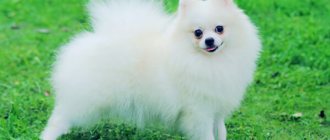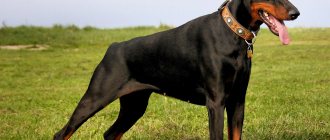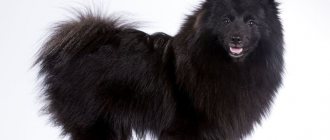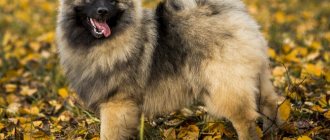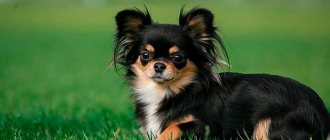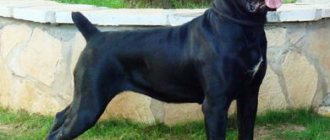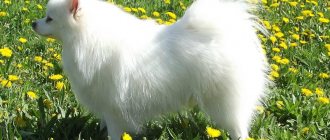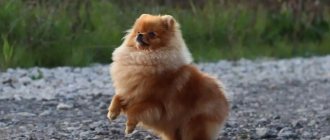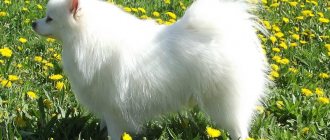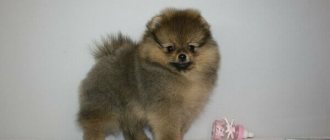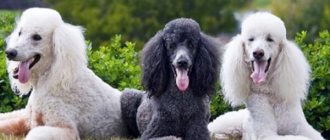Like any other dog living with a person, the German Spitz needs special education. The level of comfort in the house and the state of psychological and verbal communication between man and dog depend on how your four-legged friend is trained and how he is brought up. Considering the fact that dogs of this breed in most cases live in city apartments, the behavior of the German Spitz determines the level of relationships between the animal and the people around it.
Despite the fact that the breed is clearly not a service breed, in order for a fluffy and funny puppy to grow into a well-mannered and obedient dog, daily lessons, training and training will be required. For those who are faced with a similar problem for the first time and do not know how to raise a German Spitz, it’s time to seek advice and help from professional dog handlers. Experts will always tell you where to start the training process, taking into account the nature and characteristics of the breed, they will select the necessary methodology for subsequent training.
Pedigree puppies from breeders or in a nursery cost approximately the same. If you are offered to buy a dog cheaply, you should treat this offer with extreme caution. In such cases, there is always a high probability that you will be deceived regarding the purebred condition of the animal, or you will be offered a dog with congenital defects.
Characteristics and description of the breed
What does it look like
The parameters of this dog breed range from 23 to 29 centimeters at the withers, and their body weight ranges from 4 to 9 kilograms. The ratio of the length of the dog’s body and its height is one to one. Therefore, at the first quick glance, the small Spitz resembles a square ball of fluff. A German micro Spitz is considered an adult at 2 years of age.
The miniature Kleinspitz has a harmonious physique, all parts of the body smoothly blend into each other. And the thick and shiny coat owes its appearance to straight and coarse guard hair and downy undercoat.
Head, ears, nose
The head of the miniature Kleinspitz is wedge-shaped. By itself it is small in size. The ears are erect, in the shape of a triangle.
The orange nose is round and small. Most varieties of coat color have a black lobe, while cream and brown representatives have a brown lobe.
Jaws, teeth
The dog has a scissor bite, both jaws are developed and have a full row of teeth.
By eight months, the Pomeranian's permanent dentition is finally formed. There are normally 42 teeth in total (20 on top, 22 on bottom).
Eyes
The eyes of the little orange are oval. All color types have dark irises.
Neck and torso
The dog's neck is of medium length and gradually widens from top to bottom. The withers are well defined. A striking feature of the Pomeranian is the lush “collar” around the neck.
The back is straight, the stomach is tucked, and the chest is deep and developed.
Tail and limbs
The Kleinspitz's tail is medium in length and has an even length of hair over its entire surface. The tail lies on the back, there are also curls (both one and two).
The paws of the small Spitz are clearly muscular and set wide apart. The fingers are compressed into a ball and have hard black pads.
Coat color
Black
The black color is a unique feature of the Miniature Pomeranian. The fact is that it is rare to get a puppy of this color. Black wool always implies black skin color. Typically, puppies are not born with a pronounced charcoal color, but have brown fur.
Black and Tan
Black and tan means there are two colors in the Pomeranian's coat: black and another, lighter shade. Often the second color is sable or orange. Black, as a base, covers most of the dog's body. The second color is observed on the head, limbs and chest.
White
A truly aristocratic color, which is inherited by a small puppy from its father or mother. These babies are called “leucistic,” which means partial albinism. According to the standard, white wool should not be interspersed with other shades.
White Pomeranians usually have brightly colored noses, eyelids and lips.
Cream
Once a small baby is born, it is impossible to recognize the cream color of its coat. The cream color will become visible only after the first molt. For example, if at 5 months a cute Spitz is snow-white or beige, then after changing its coat it will become creamy.
Cream color, in turn, can be rich (warm) and cold. The latter is sometimes difficult to distinguish from snow-white wool.
Ginger
This is the most common and famous color of the miniature orange in the world. Red Spitz can be either bright red or more close to beige.
Sable
This color combines two shades. With it, the guard hair has a heterogeneous color: at the base it is light, and towards the tip it becomes dark. This creates an iridescent effect on the fur. Sable color comes in the following subspecies: gray, cream, red or orange sable.
Orange
This is a variety of red color, characterized by rich color. Orange dogs have brighter, richer fur. To understand whether a puppy will grow up orange, you need to pay attention to its ears. If they are bright orange, then with a high probability the baby will acquire the same color after the first molt.
Paticolor
This color of the miniature orange is characterized by the presence of two tones: the main one and the additional one. The main color in all cases is white. The inclusions come in different colors, for example, black, brown or orange. Black and white orange is common.
The paticolor color is considered the standard color when specks of an additional color cover the dog evenly and symmetrically.
Types of small German Spitz
The Miniature Kleinspitz is a super-mini dog breed. This is a subspecies of the German Spitz breed. It is very similar to the Pomeranian, but is considered an independent variety. Another variety of German Spitz is the Grossspitz. The weight of a Gross Spitz boy can reach 22 kilograms.
Character and behavior of the dog
The character traits that the Small German Spitz is known for are:
- The desire to be a leader. When a minik gets into a new home, it quickly gets used to and adapts there. And that’s when active attempts to show leadership begin. Methods of influence include complaints, manipulation and tricks. It is important to promptly let your pet understand that such behavior is unacceptable. It is necessary to stop the attempts of the four-legged creature to “set the tone.” It is necessary for him to understand the following: the owner must be respected and obeyed. There is no need to be afraid to say “No” strictly.
- Attachment to the owner. So strong that the pet does not leave the person for a second. A devoted companion will do his best to adapt to the comfortable lifestyle of the owner.
- Excessive playfulness. Small children like this quality: the dog entertains and makes them happy.
- Distrust of strangers and animals. The alertness of the miniature German Spitz is often manifested by a piercing loud bark. Therefore, it is necessary to wean the little Pomeranian from barking without a reason even in childhood.
Intelligence
The intelligence of the German Spitz is amazing. This is a smart dog with a high learning rate.
Historical roots
The ancestors of the German Spitz with recognizable proportions and a fox-like muzzle lived in what is now Sweden. Their remains and images in the form of ornaments on utensils were discovered during excavations of ancient settlements. Archaeologists date it to the 8th-10th century BC. Written references to the Spitz were made in the 15th century; the dog is shown in them as a sociable and friendly dog. The German naturalist Fitzinger in 1867 wrote a description of 48 species of Spitz. In all his work, the dog is described as a friend and helper, protector and companion.
Friends of geniuses and nobles
In Germany, hounds began the selection of miniature Spitz dogs; the weight of the dwarf representatives was only 4 kilograms. “Spitz” is translated from German as “sharp” - the dog’s thin, recognizable muzzle is like the calling card of this breed, with the telling name “sharp”. Smart dogs with playful eyes and attractive bright fur coats began to conquer the boudoirs and palaces of noble people.
Sharp muzzle shape
Queen Victoria of England brought a mini-Spitz to England, which increased the popularity of these funny dogs, surprising in their size. She also became the first breeder of dwarf Spitz dogs in England. Royal pets have taken prizes at exhibitions since 1915, and the English club allowed dogs weighing no more than 3.6 kg into the exhibition. The most common colors at that time were sand, red and hazel.
In the famous work “The Lady with the Dog,” Chekhov described a Spitz dog, and in Charles de Coster’s novel “The Legend of Eulenspiegel” there were also dogs of this ancient breed. Famous owners of the breed were:
- Empress Catherine;
- Marie Antoinette;
- Michelangelo;
- Martin Luther;
- Mozart;
- Emil Sohl;
- Ludwig Richter.
With the development of transport in the world, the mini Spitz conquered America. Cynologists of this country have made a huge contribution to the development of the breed. "Americans" have a stable color, strong bones and easy movements. The coat of the representatives of the breed has a bright color and the necessary thick undercoat.
Dwarf Spitz dogs in France resemble the dogs of the past, they have long, pointed muzzles and large ears, but the body of individuals of this breed is large, which is bad for dwarfs.
In Russia, up to 50 German Spitz dogs were exhibited at major exhibitions in the 70s of the 20th century. After the fall of the Soviet Union, foreign representatives of the breed began to be brought into the country, which in 30 years completely replaced the old type of dogs.
Photos of old type dogs
Differences between male and female
The gender of a Miniature German Spitz affects the dog's appearance and personality. For example, boys have the following:
- larger body;
- very fluffy and thick coat;
- Shedding is easier because less hair is lost;
- increased emotionality;
- They are almost incapable of cunning and manipulation.
But for a German Spitz Minik girl the following is characteristic:
- cleanliness;
- more balanced, calm character;
- the ability to manipulate and deceive;
- less expressed emotionality;
- frequent long-term shedding: before estrus, after childbirth.
But regardless of whether it is a girl or a boy, the pet will be devoted to its owner to the last, like a child.
Psychology
All Pomeranians are friendly, intelligent, intelligent and make excellent companion dogs.
The largest, the Keeshond and the Great Spitz, like the Schipperke , are vigilant and capable of protecting the owner.
Medium and small are cheerful dogs, like miniature pinschers and Norfolk terriers , who love to run and play. They love water and swim willingly, and enjoy frolicking in nature.
The puppy should be raised affectionately, but firmly - these are pack dogs, they need a smart leader.
Small pets should be weaned from loud barking for no reason and excessive bullying towards large dogs.
The medium and small Spitz are cheerful dogs that love to run and play. They love water and willingly swim, and enjoy frolicking in nature.
Care and education of the little orange
Eye and ear care
Eye and ear care measures include the following procedures:
- Clearing the eyes of accumulated secretions. To do this, you need cotton pads and warm water, or chamomile decoction. If redness is visible, you need to wipe with brewed strong tea.
- Cleaning the ears from wax. Again, you need a cotton pad or swab. They usually clean them with special lotions for the ears, but you can use calendula tincture or boric alcohol.
Tooth and nail care
Most dog breeds are prone to dental problems. Among them are the formation of tartar, stomatitis, caries and even periodontal disease. Therefore, dental care consists of the following:
- Every day, use a soft toothbrush and dog toothpaste to clean your small pet's teeth.
- You need to buy your dog a special dental stick. By chewing it, he additionally protects his teeth from plaque.
As for the claws, they will need to be trimmed only when they significantly interfere with the pet when walking and do not grind down on their own. Haircuts are given both in salons and at home. To carry out a haircut at home, you need to purchase a nail clipper. You need to cut off the transparent part of the claw, which is empty inside.
Grooming
Caring for the impeccable coat of a German mini Spitz includes grooming, that is, cutting and periodic washing. More about all this later in the article.
Proper nutrition
How a small pet eats directly determines its health and life expectancy. You can feed oranges with prepared food and natural products.
When feeding your dog dry food, you must follow the following rules:
- The food class should not be lower than premium. Ideal – holistic.
- The food must be free of chemical additives and preservatives.
- Dry granules should completely cover the dog’s need for microelements and vitamins.
- You need to create a feeding regimen and not deviate from it. It is enough to feed an adult Small German Spitz twice a day.
- There must be clean boiled water next to the bowl. Change it daily, and if necessary, several times a day.
If your miniature pet is on a natural diet, you need to know the peculiarities of such nutrition. Important rules for feeding natural food to a German Spitz are as follows:
- balance: proteins in a proper diet are at least 70 percent. Proteins mean meat and meat by-products, fermented milk products (mainly kefir and cottage cheese). The rest comes from cereals and vegetables;
- the pet should not overeat;
- You should not give your Pomeranian food from the owner’s usual table. After all, it is rich in salt, seasonings and sugar. This is all harmful for your four-legged friend and will cause him big health problems;
- you need to cook every day, that is, food prepared for oranges must be fresh and warm;
- maintaining a balance of vitamins and minerals. It is recommended to buy your dog a special vitamin complex;
- We must not forget about clean drinking water and ensure free access to it.
Hygiene procedures
Pomeranians should only be washed in the bathroom if necessary. You need to bathe your baby as little as possible, otherwise the condition of his skin and fur will noticeably deteriorate.
If your little pet gets dirty or returns home after a walk in the heat, it is better to use dry dog shampoo.
Pomeranian grooming, molting
Grooming is the most important procedure for a small German Spitz. It is needed not only to give the mini a well-groomed look, but also for:
- removing excess hair, which is an excellent breeding ground for bacteria;
- ridding your pet of matted tufts of fur that cannot be untangled by hand;
- eliminating the risk of the spread of ticks, fleas and other parasites living on the skin.
If the owner does not take the miniature pet to shows, the haircut can be done at home. It's quite easy to learn. It is permissible to cut a German Spitz for the first time only after shedding has completed, i.e. after nine months of age.
The following recommendations will help you groom your German Mini Spitz at home:
- Preparation for grooming means thoroughly combing your pet's fur. You need to take a comb with sparse teeth and start combing against the grain. Especially treat the groin and axillary areas, the hair between the toes;
- To prevent the wool from generating static electricity during combing, antistatic agents must be used;
- After the combing procedure is completed, you need to bathe the dog and wash him with dog shampoo. After bathing, pat the coat dry with a towel rather than rubbing it. Finally, dry the coat with a hairdryer;
- You will need straight scissors with sharp blades, as well as a comb with long teeth. Additionally, it is allowed to use thinning scissors;
- For the haircut itself, a machine is also suitable.
The first shedding of the Small German Spitz begins between three and nine months. Some miniature German Spitz dogs begin shedding at 10 months. During this period, the little puppy loses its baby fluff and acquires an adult coat. During the first molt, you need to brush your baby often: this will help him get rid of old fluff faster. If molting began early, then at 4 months the German baby will be almost bald.
The second shedding of the Small German Spitz begins at the age of one year. At this moment, the dog finally changes its undercoat.
Subsequent molts of the minik occur in spring and autumn. Sometimes they begin to shed in hot summers due to temperature changes.
The final coat change occurs at 1.5 years. At this age, the small animal becomes fully mature. The wool already consists of two layers - the undercoat and the layer of guard hairs.
The Small German Mini Spitz's coat continues to grow until it is three years old. And only then will the pet’s final rich coat be formed.
Training, raising a dog
Any dog without proper training will behave willfully. This also applies to the miniature German Kleinspitz. This breed is known for its energy and intelligence. Therefore, it is necessary to direct this energy in a timely manner in the right direction.
Minik training begins from puppyhood. The Pomeranian must understand that the owner must be obeyed, that the authority in the house is the person, not the dog. At first, education is aimed at suppressing the desire of the Pomeranian to dominate everywhere and over everyone.
The goals of raising a grown-up German puppy are:
- accustoming to the surrounding world and society, the ability to behave in public;
- ridding the baby of jealousy and aggression;
- learning to express emotions more restrained.
When the owner finds a common language with the little German Spitz, it’s time to start training. Basic commands that dogs are taught include:
- "Ugh".
- "Sit".
- "Aport."
- "To me".
After mastering the basic skills, you can begin to learn complex commands and actions. The Small German Spitz is an incredibly smart breed. Minik is capable of performing interesting acrobatic tricks and even performing magic.
How does pregnancy and childbirth proceed?
Knitting a small German Spitz is allowed after the physiological formation of the dog is completed. For girls it ends at 15 months, for boys at 12. A female must go through at least two heats before her first mating. You cannot breed during your first heat.
Rules for breeding miniature Kleinspitz:
- First of all, you need to make sure that both dogs are healthy;
- choose a partner of the same size;
- A female should not give birth more than once every two years. This is a huge burden on her body. The girl needs to recover after pregnancy.
Caring for a pregnant miniature German female takes a lot of time. And important changes concern the dog’s diet. The number of feedings increases to three times a day.
To prepare for childbirth you will need:
- disinfect the room where the dog will give birth;
- show the female this place, let her get used to it;
- you need to prepare cotton diapers, napkins, medicines and treated scissors;
- Find out the phone number of the veterinary hospital so that in case of emergency you can call a specialist for help.
Before giving birth, the female's behavior changes, so it is impossible to miss this moment. During childbirth, you do not need to leave the female; you should always be ready to provide first aid. It is necessary to talk gently to the dog and give it words of encouragement.
Usually, the female mini-Kleinspitz herself gnaws the umbilical cord of a newborn puppy. But in some situations she needs human help.
After the birth of each puppy, the placenta comes out. You need to make sure that their number matches the number of puppies. The labor of a German Kleinspitz lasts up to four hours.
Health, frequent illnesses
German Mini Spitz dogs usually do not have serious health problems and are not prone to hereditary diseases. However, in these individuals with the following developmental features, the risk of disease increases slightly:
- malocclusion;
- dense skull bones;
- bulging eyes;
- non-standard color;
- deviations in the structure of the respiratory system.
The listed developmental features of the small German Kleinspitz often lead to the following diseases and abnormalities:
- hypothyroidism and other disorders of the thyroid gland;
- dental problems: tartar, periodontal disease, caries, etc.;
- respiratory tract diseases;
- snore;
- hip dysplasia;
- eye diseases, increased lacrimation.
But there are also problems that are typical for all German Spitz:
- tendency to allergies. It often manifests itself as a skin reaction;
- tendency to obesity. Overfeeding will quickly lead to weight gain. As a result, metabolism is disrupted and serious consequences occur.
Feeding a German Spitz: what to feed your dog?
How and what to feed a German Spitz so that the dog remains in good physical shape for as long as possible, and his coat is beautiful, strong and shiny? The puppy needs to be fed 3-4 times a day, making up the correct diet. It is enough to feed an adult pet 2 times a day. It is best to give food at the same time, leaving enough in the cup so that the dog eats it completely. If after eating the dog licks the cup, the dosage of food is increased, but if it leaves the food, it is reduced.
To make feeding a German Spitz healthy, it is important to include boiled and raw meat (beef, lamb, poultry, horse meat) in the diet. It is also necessary to give cottage cheese, eggs, vegetables and fruits. It is better to replace milk with fermented milk products. Before you start adding vitamin and mineral supplements to your food, you need to consult a specialist.
What the Small German Spitz breed looks like, see the photo below:
Advantages and disadvantages of Kleinspitz
Advantages of the German Spitz:
- Sociability, friendliness. Thanks to these qualities, the minik will quickly get used to a new home and a new family.
- Wits and intelligence. The breed is well trained and quickly remembers commands.
- A small German Spitz can be trained to go to the toilet at home. For this you only need a tray.
- Compactness. It is convenient to take your pet with you. After all, the dimensions of the German mini-Spitz are 23-29 cm at the withers.
- Tolerates changes in climatic conditions, temperature and cold changes well.
The relative disadvantages of the German Kleinspitz include the following:
- The need for careful coat care, especially during shedding.
- The next disadvantage follows from the previous one - the ability to cause allergies.
- If there is a lack of upbringing, the pet will chase other people's animals and get into fights with them.
- Touchiness. This baby can harbor a big grudge against its owner.
- Jealousy. The miniature German Kleinspitz will not allow its owner to communicate with anyone else. A person is his property.
- Inability to be alone. Otherwise, the apartment will be seriously damaged.
- Loud barking. An ill-mannered pet will bark for every reason.
Peculiarities
The Small Spitz has a cheerful and mischievous disposition, loves to play and can frolic throughout the day. He is inquisitive and interested in everything around him. Despite its size, the Spitz is an excellent guard, thanks to its acute hearing. The baby is patient and allows even the smallest children to play with him. Only if he is hurt is the dog able to snap back or show aggression. The Spitz is very emotional, loves attention and affection, quickly grasps all commands on the fly and is easy to educate and train.
The dog does not tolerate loneliness well and it is better not to leave him alone for a long time. It is advisable to start socialization as early as possible, as the dog may be intimidated or afraid of loud noises and other things. Animals show caution towards strangers, but without aggression. The Spitz easily gets along with absolutely all pets: cats, dogs, rodents, birds. Their devotion to their loved one is enormous: the dog becomes very attached and has difficulty withstanding a change of owner.
Jealousy is inherent in kids: it is important for them to have a lot of attention and affection, otherwise selfishness breaks through in their character. If Spitz dogs don’t like something, they will openly tell everyone about it, even in front of strangers - loud and ringing barking should be taken into account when choosing a puppy for an apartment.
Health
Characteristic diseases
This is a naturally strong dog. Among the diseases that Spitz dogs are susceptible to:
- subluxations and dysplasia of joints;
- problems with the thyroid gland;
- obesity;
- conjunctivitis, in old age - retinal dystrophy, cataracts , glaucoma;
- colitis, gastroenteritis (with poor diet);
- allergies , dandruff, eczema;
- tartar.
You can learn more about obesity in dogs from the article
The German Spitz feels great both in a city apartment and in a country house
Even the German miniature Spitz-Pomeranian requires regular exercise, but large species require walking.
Each pet also needs a balanced diet and attention from the owner.
Vaccinations
At the age of 2 months, the puppy must be vaccinated against viruses (enteritis, hepatitis) with revaccination after 2 weeks.
At 2.5 months, a vaccination against canine distemper is given, with revaccination at 6-7 months.
The rabies vaccine is given to dogs no earlier than 8 months.
Information about vaccinations is entered into the dog's card.
The further schedule is drawn up by a veterinarian, but before each injection it is necessary to drive away helminths, and after vaccinations, quarantine must be observed until an immune response is formed (up to 20 days).
German Spitz in a flower garden
How to choose a puppy
- determine what you need the Pomeranian for: for exhibitions and breeding - take show and breeding prospects, for the “soul” - pet; choose from mature dogs;
- find a kennel with a good reputation, registered in the RKF, so as not to buy an expensive pet-class puppy;
- study the pedigrees of the dogs of the selected kennel, evaluate several litters;
- decide whether you need a female or a male: girls are better for breeding, but shed a lot, boys are less devoted, but never “undress” completely and shed unnoticed;
- choose a pet aged three months or older, no younger, with the required vaccinations, treatments for helminths and external parasites;
- evaluate the behavior (active), character (without fear of strangers), intelligence and appearance of the puppy, while taking into account his age (“baldness” of Pomeranians from 3 to 8 months is not a disease, but molting);
- evaluate the puppy’s environment and maintenance (cleanliness, quality of food, health of “neighbors”);
- touch and examine each puppy in the litter, don't limit yourself to just one.
Every country has its own opinion
Let us immediately note the fact that the German miniature and Pomeranian Spitz are classified as separate breeds in some countries. These include England, America and Canada. In Russia and Germany, the Pomeranian is considered a dwarf variety of the German Spitz.
The American Kennel Club standard can be found in the article “Pomeranian Spitz Breed Standard”. Next, we will describe the structure and characteristic features of the classic small (Kleinspitz), medium-sized (Mittelspitz) and miniature (Zwergspitz) German Spitz, officially accepted by the FCI and RKF.
The description of the standard features of the small group Spitz includes the structure:
- torso;
- heads;
- housings;
- limbs.
We will also talk about the coat, colors, sizes and temperament of these dogs.
Small eyes, pointy ears, strong teeth
The neat ears of the Spitz have a triangle shape and a high-standing position. The distance between them is relatively small. Huge, floppy, far apart ears or rounded ears are considered a defect.
The dog's slanting almond-shaped eyes have a dark tint and a perky expression. Distrust appears in them when a stranger approaches. The color of the eyelids, as in the case of the nose, depends on the color of the coat. Barely noticeable, huge, protruding, drooping or round eyes are undesirable.
The animal must have a full set of strong teeth - 42 pieces, however, in small and dwarf varieties of the breed, the absence of two or three premolars is allowed. All dogs have a scissor bite. Due to the structure of the muzzle, the German Dwarf Spitz may have an overbite. But underbites and snacks are unacceptable.
Spitz development and weight by month table
The table shows the development of the puppy by month.
| Age | Weight, g | |||
| Birth | 85 | 125 | 150 | 170 |
| 1 month | 280 | 450 | 600 | 670 |
| 2 months | 450 | 680 | 910 | 1050 |
| 3 months | 625 | 995 | 1270 | 1440 |
| 4 months | 850 | 1250 | 1600 | 1800 |
As the baby grows, his appearance changes along with his height and weight.
Behavior
The character of the German Spitz is unique. From the first days of its existence, the breed developed alongside man, helping him farm and brighten up his days. That's why dogs know how to adapt. With calm owners, they lie on the sofa under the steady hum of the TV, with lovers of sports and outdoor activities, they explore the world.
This does not mean that dogs are couch potatoes. They are active, they need to play, walk and be mischievous every day. It’s just that the character of a German Spitz depends on the temperament of the owner. The saying that dogs are like their owners suits this breed like no other. With choleric people they will be hyperactive, with phlegmatic people they will be calm.
All types of German Spitz are sociable and cheerful. They love family. But the attitude towards strangers is different. Decorative breeds are usually friendly, while others are wary of strangers.
Like any dog, Spitz dogs have advantages and disadvantages. They are devoted to their owner and household members, love affection and participate in everyday affairs. But they cannot stay alone for long, even in the next room. You should prepare for the fact that a furball will follow a person around the apartment and poke its nose everywhere. Sometimes it's annoying.
Another disadvantage is excessive loud barking. You can recognize a German Spitz by its abrupt voice, even without seeing the dog. They need to be told everything about even minor events - the arrival of neighbors, a conversation behind a wall, a car passing under the window. They are weaned off this from puppyhood.
Animals are companions that will follow their owner through thick and thin. No matter what a person does, they will be there. After all, the company of people is the best reward for them.
How much does a Pomeranian weigh at birth?
A competent breeder approaches the birth of a dog responsibly. When puppies are born, you always have a kitchen scale, a pen and a notepad at hand. The newborn baby must be weighed, the data recorded and then the dynamics of weight gain monitored. This is necessary so that the breeder can assess the development of the puppy. Miniature Pomeranians weigh approximately 85 g at birth, while larger ones can weigh around 170 g.
What determines the weight and size of puppies?
The development of a puppy is an individual matter. Every dog develops differently. This depends on certain factors:
- Heredity. Large parents often produce heavy puppies. Therefore, if the baby exceeds the standard, you should familiarize yourself with his pedigree;
- Nutrition. Even if born with a normal weight, a puppy can actively gain extra pounds if it is overfed. Or, conversely, it may lag behind the standard;
- Vitamin supplements. For proper growth and development during the period of active formation, the puppy must receive the necessary nutrients;
- Hyperactivity. Long active walks affect the development of the dog’s muscle corset, which also adds weight.
Application
In the past, large species were considered weapon animals and were used in hunting.
Today, all Spitz dogs are well socialized and are suitable for living in a city apartment.
They become attached to their family and do not tolerate separation and loneliness well.
A long-neglected dog can turn into a spoiled, aggressive creature.
An artistic dog can learn some tricks that will entertain him and his owner.
Good at agility .
Nuances in the development of different subspecies
The maturation of different types of Spitz proceeds approximately the same. Regardless of the breed, the development from a baby to an adult dog takes three years. They reach their final size by about six months.
There are some features:
- One litter may produce pets of different weight, height and color.
- A miniature size that does not meet standards may indicate the presence of diseases. Harnesses and collars are not suitable for these puppies. They should not jump from heights to avoid damaging their joints.
- If your pet is larger than the accepted standards, accept it. Most often, the reason is the presence of large individuals in the pedigree. It is impossible to influence the size of a pet without harming its health.
